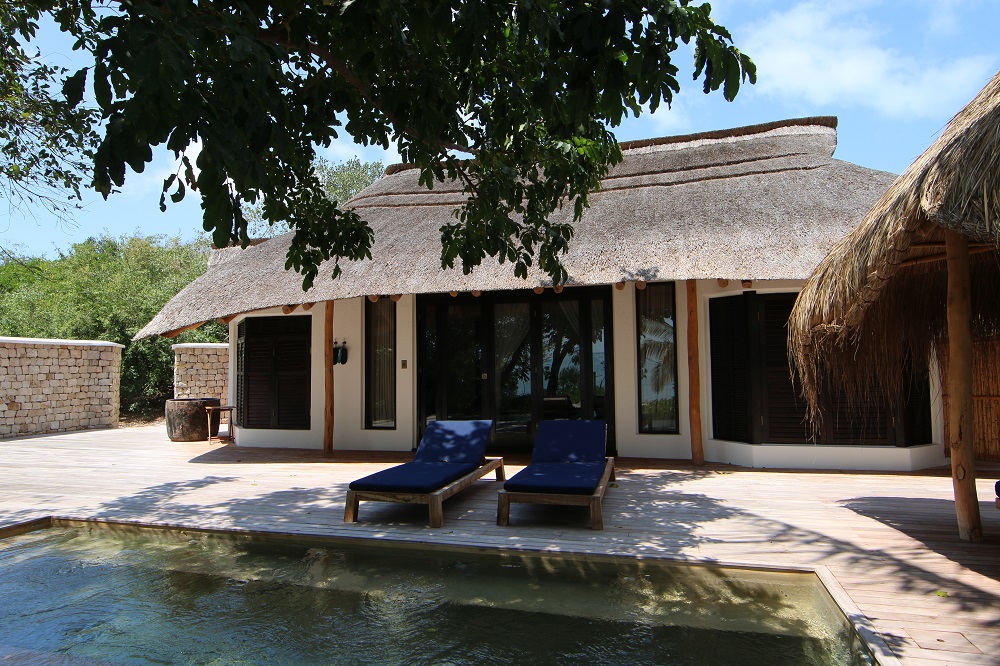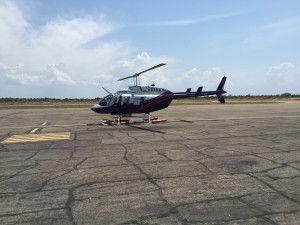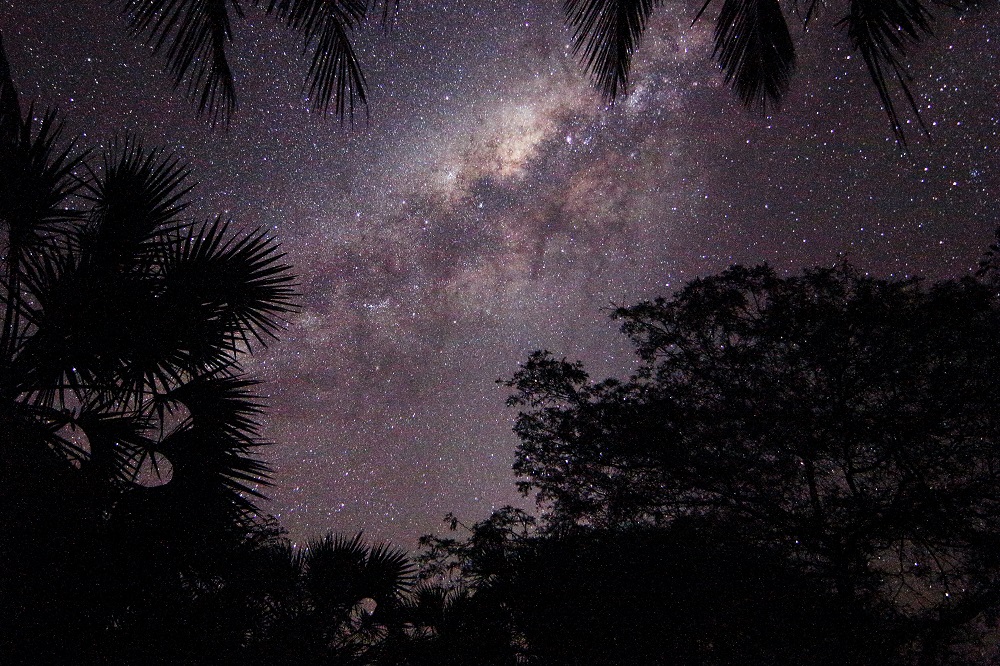It is safe to say that since a two week trip to Namibia in 2011, which culminated in a four night stay at the &Beyond Sossusvlei Desert Lodge which offers some truly fantastic stargazing under some of the darkest skies in the world, I have somewhat fallen in love with Africa. While perhaps a cliché, there is something quite spiritual about Africa, offering experiences and sights not rivalled by anywhere else. However, as an astronomer, those wonderful dark skies with the Milky Way arching across the sky are often tantalisingly out of reach. When on safari, the camps and lodges are often completely open with all the local wildlife free to pass through as they please. The prospect of coming face to face with a creature that would like to make me a midnight snack keeps one inside during the night.
When the time came to choose a summer holiday for 2015, I was looking for total relaxation. The prospect of doing as little as possible for two weeks really appealed. Once again, Africa beckoned with its numerous golden beaches, reliable weather and fantastic hospitality. Having had wonderful experiences with &Beyond previously, we decided on the Benguerra Island resort, recently subject of a $6mn renovation. A quick check with the &Beyond booking team confirmed that the island would be safe for stargazing, so one of my small scopes would also be making the journey to Africa. This also meant the holiday was timed so that the October New Moon fell in the middle of the holiday to maximise the benefit of the dark skies.
Benguerra Island
Located on the second largest island in the Bazaruto Archipelago off the coast of Mozambique, the Benguerra Lodge consists of just 10 Casinhas, two Cabanas and one 3-bedroom family residence (meaning there is always less than 30 guests at any one time) wrapped around a curved golden beach that looks over the beautiful turquoise and azure warm waters of the Mozambique channel. Arrival at the island resort is via a 15-minute helicopter ride from Vilanculos airport on the mainland which provides wonderful views of tranquil waters peppered with locals fishing from their wooden Dhows.
Nestled in the lush vegetation of palm trees and flora of the island, each room is secluded offering a good level of privacy. Constructed from natural materials, each residence boasts glass folding doors which open up over a wooden deck with plunge pool and down onto a small garden area and the long golden sands of the beach. The tidal variation is quite remarkable, fluctuating by over five metres with the beach only a few metres wide at high tide but stretching out close to 50 metres at the low.
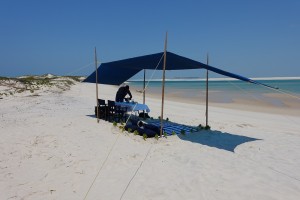
The finishing touches to our castaway picnic were just being set as we arrived. It was a real highlight of all the activities we experienced.
As one might imagine with a venue nestled on a beautiful beach in the Indian Ocean, many of the daytime activities are focused on the water. With a fully equipped dive centre, snorkelling and scuba diving are offered on the stunning coral reef which is 30-minute boat ride away as well as the opportunity to gain PADI certification. Deep sea fishing expeditions and sunset Dhow cruises with a local skipper are also available. Land lovers are not forgotten. A horseback ride around and into the interior of the island is a wonderful experience (my horse was appropriately named Stardust) but the real highlight is the Castaway Picnic. Taken to a secluded beach on the other side of the island, with only a few small crabs that scurry in the surf of the gently breaking waves for company, you are left for afternoon to enjoy the view and relax with a delicious picnic prepared by the talented chefs of the resort. The feeling of being alone on a tropical paradise with a soundtrack of breaking waves and bird song is something I will never forget.

Taken less than 45 minutes after sunset, the Milky Way and Zodiacal light dominated the view to the west (Click for larger image)
Quality of the night sky
Unlike some of the other locations I have travelled to with the intention of observing, the night sky has not been officially assessed by entities such as the International Dark Sky Association. However, it is most certainly worthy of their attention. Only minutes after sunset, the Sagittarian region of the Milky Way comes easily into view and dominates the sky as did the zodiacal light stretching up from the western horizon where the Sun had been only a short while before. On several clear moonless nights during my stay I assessed the limiting magnitude using Capricornus which was at the zenith in the evening a few hours after sunset. My average estimate was around magnitude +6.6-6.7 which while not the darkest sky I have had the pleasure of observing under, it will certainly please any amateur astronomer who hopes to observe while on holiday. The light pollution map confirms my own observations that there isn’t any major source of light pollution with only a minor distraction coming from the Azura resort which is further along the beach in the north-east. During our holiday we stayed in Casinha number 1, which is furthest from the communal area and means there is no need to worry about lighting from other rooms interfering with the observing location on the beach. If you intend to observe, I recommend requesting number 1 in advance of your arrival.
While the sky at the zenith is very dark, as is the sky over the island, there is a noticeable, but certainly not prohibitive to observing, level of atmospheric extinction over the sea. It really only becomes an issue below an altitude of approximately 20 degrees. The only other problem to report was one that caught me rather by surprise, and that was dew. In the summer months in particular (Oct – Feb) it can be rather humid and the objective lens of my refractor completely fogged up on one night. With no equipment to prevent the onset of dew, I was forced to bring the scope inside to warm up. Conditions were good that night so I went back outside once the dew had evaporated from the scope. Certainly something you might want to equip yourself to fight against if you visit during the humid summer months.
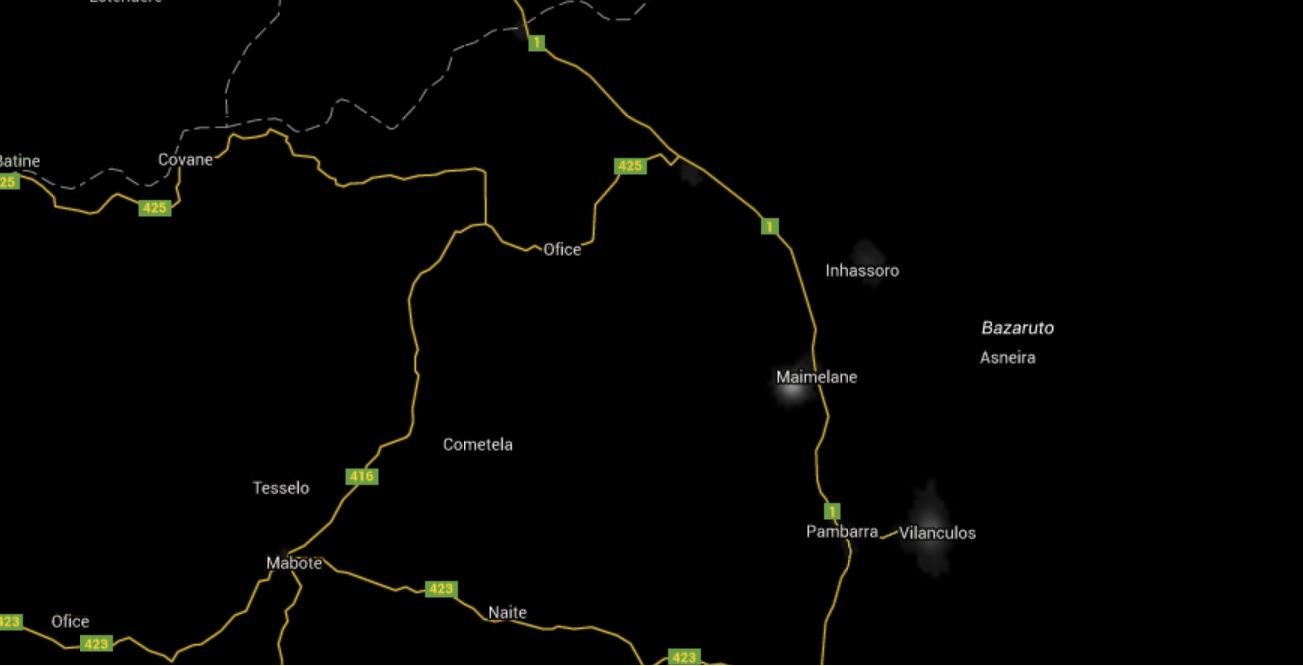
A light pollution map showing the region around Benguerra reveals little in the way of light pollution. Credit: Blue-marble.de
I also kept a log of the night time weather during my stay. While such a small sample set cannot be used to draw conclusions about the likelihood of clear skies, we certainly enjoyed a large number of nights where observing was possible.
My Observing Equipment
Currently there is no telescope equipment at the lodge, though speaking with management, they are well aware that they benefit from dark skies which could provide another activity for guests as it does at the &Beyond Sossusvlei Desert Lodge in Namibia where they have a 12” LX200. Fingers crossed they build a small observatory in the future though they will need to consider methods of dew prevention. As such, currently you have to bring your own equipment. The helicopter transfer from the mainland does somewhat limit luggage allowance, and given I also wanted to bring some camera equipment to capture wide-field night time images, I packed my smallest scope, the 6cm aperture Takahashi FS-60. This scope is light weight enough that is more than amply supported by a small photo tripod and head. Rounding out the equipment were just three 1.25” eyepieces, the 24mm Panoptic (15x magnification / 4.4o field), the 10mm Radian (36x / 1.6o) and the 3-6mm Nagler Zoom (59x / 0.8o to 118x / 0.4o).
Stargazing
I split my stargazing into three distinct sessions during the two week stay, covering early evening, around midnight and a couple of early morning sessions to take advantage of the changing constellations and DSOs that come into view.
The Evening Session
While any northern hemisphere based observer’s mind quickly focuses on some of the showpiece gems of the southern skies such as 47 Tucanae and the Eta Carinae Nebula, there was a higher priority target for the evening session due to the limited observation window before it disappeared over the horizon after sunset. Anticipation was building for comet C/2013 US10 Catalina among my local astronomy club, but it had not yet moved northward enough to be visible from the UK. Though not quite naked eye visible in the twilight sky, it was an easy hop from Eta Centauri. Using the 10mm Radian, a small tight coma was visible with a short, stubby tail extending diagonally away from the recently set Sun.
After getting my fix of a transient visitor to the inner solar system, I moved onto the Sagittarius / Scorpius region of the Milky Way. This area of sky is never well placed for viewing from the UK, skimming along the southern horizon in murk and light pollution hiding so many wonderful nebulae and clusters that pepper the sky in the direction of the galactic centre. I started with the open cluster M7. Known since antiquity, it is visible to the naked eye as a distinctive brightening in the Milky Way. The cluster extends to 80 arcminutes in diameter and was well framed by the 10mm Radian. Even in the small Takahashi, the cluster was a beautiful sight, with dozens and dozens of tiny jewels resting gently on the wispy clouds of the Milky Way. A short hop away is the open cluster M6. Known as the Butterfly Cluster, it stands in stark contrast to M7 as it sits to the side of the Milky Way clouds in a jet black background. Much smaller in apparent size at only 20 arcminutes, the view was most pleasing using the 5mm setting on the Nagler Zoom.
Emission Nebulae are my favourite type of DSO, and this area of sky is home to some of the best. Starting with M20, the Trifid Nebula, the distinctive dark lanes that bisect the emission nebula were easy to see. The associated reflection nebula proved more elusive in the tiny Tak, only hinted at with averted vision. Not far from the Trifid lies the Lagoon nebula. Were it better placed to view from mid to high northern-latitudes, it would probably be as praised and well known as the Orion Nebula. Bright enough to show a green-hue even in a tiny scope, the 10mm Radian took in the whole nebula which extends over 1 degree on the long axis. The beautiful open cluster, NGC 6530 which nests on the eastern side of the nebula in delicate wisps and swirls of excited gas rounds out a spectacular view in any telescope. M16 and M17 also had some telescope time.
Having temporarily sated my desire for emission nebulae it was time to move onto some of the true jewels of the southern hemisphere sky, the globular cluster (GC) 47 Tucanae and NGC 2070, better known as the Tarantula nebula. Located off the shoulder of the Small Magellanic Cloud (SMC), 47 Tucanae impresses in any scope. One of the most massive GCs in the Milky Way, containing millions of stars, it is three times brighter than M22, the brightest Messier GC and only bested in apparent brightness by the most massive globular, Omega Centauri. The view in the FS-60 showed hints of granulation around the edge of the cluster with an obvious intensity increase towards the centre. Certainly my personal top pick among all GCs, it is one of the DSOs that causes me the most envy when thinking about our southern hemisphere based astronomer cousins.
Located in the constellation Dorado in the Large Magellanic Cloud (LMC), the Tarantula Nebula (NGC 2070) is my favourite DSO and not just because of the remarkable view in a telescope of any size. Visible to the naked eye as a slight brightening on the edge of the LMC, it is the largest of dozens of emission nebulae that pepper the Milky Way’s satellite neighbour. Staggeringly large in size at approximately 600 light years across, it dwarfs the famous Orion Nebula (24 LY in diameter) and is in fact the largest star forming region known in the local group of galaxies. Were it located at the distance of the Orion Nebula (c.1,300 LY) it would actually cast shadows on the Earth! In the FS-60, a gentle green hue is seen on the delicate tendrils of excited hydrogen gas that give the nebula its name.
A large scope will reveal hundreds of stars that form a compact cluster at the heart of the nebula that generate most of the energy which causes the gas to glow. In the baby Tak, a few of its brightest members are seen, along with the combined light of the entire cluster that create an obvious brightening near the nebula centre. It is a view I will never tire of, though it is the combination of the sight at the eyepiece and the knowledge that I am viewing a stellar nursery in another galaxy which makes it truly magical.
Having reacquainted myself with my favourite, yet rarely seen DSO, I made the 20 degree hop to the SMC once again. Not to view 47 Tuc, but to take in the entire galaxy itself. Located 200,000 LY away, the galaxy spans approximately 5 degrees by 3 degrees which left me wishing I had taken along one my low power 2” Eps which would have easily taken in the whole galaxy in a single view. Having to be content with the 4.4o field of the 24 panoptic, the field was a bright mass of tiny pinpricks of light too numerous to separate with hints of abundant nebulae and clusters that litter the galaxy, revealed by localized brighter patches in the blanket of stars that form the dwarf galaxy. Having spent time viewing both the LMC and SMC with large aperture instruments, I found it remarkable that I was able to glimpse individual DSOs in another galaxy outside of the Milky Way with such a small instrument.
With the evening progressing and a wonderful dinner and drinks beckoning further up the beach, I packed the scope away, already anticipating my next observing session that would come a few days later.
The Midnight Session
The midnight session was very peaceful. By this time all the guests had retired for the night and my only company was the sound of gentle waves lapping against the shore and a small amount of bio-luminescent plankton that were churning in the surf. It was quite a backdrop to begin a galaxy and GC hunt that would dominate this part of the night. With such a small scope, a session focused on dim light of distant galaxies might sound like an exercise in frustration, but I had my sights set on some of the brightest and spectacular galaxies located in Sculptor. The constellation may be small and dim, though it easily found near Fomalhaut in Piscis Austrinus, but in contains the most impressive galaxies I have ever seen visually.
Starting with NGC 253, often known as the Sculptor Galaxy or Silver Coin, its distinctive elongated shape was immediately obvious at 35x in the Radian. NGC 253 is categorised as a starburst galaxy as it is currently undergoing an intense period of star formation. When I have viewed this galaxy in larger instruments it presents a wealth of detail with molted and twisted dust lanes with direct vision. Such detail was not so readily apparent in the tiny Tak. However, using the 6mm setting on the Nagler Zoom with averted vision I was able to make out some distinct variations in brightness which hints at the detail I know can be seen with a larger scope.
Moving on to my particular favourite, NGC 55 provided the most memorable view I have ever had of a galaxy using a 12” scope in Namibia. At magnitude 8.8 it is the second brightest galaxy in the Sculptor Group and excellent example of an edge-on barred spiral galaxy. In the 12” scope an almost overwhelming amount of detail is visible and it only gets better the longer one studies it. In the 2.4” scope at 59x, the distinctive spindle shape (32.4’x5.6’) is easily seen. Averted vision indicated the presence of some of the detail that enthralled me in Namibia.
Taking in NGC 300 but completely forgetting about NGC 247 which is just over the border in Cetus though still a member of the Sculptor Group, I turned my attention to the some slightly nearer celestial neighbours, a number of globular clusters in the Capricornus / Aquarius region of the sky.
M2 in Aquarius was my first target. Just about visible to the naked eye in the west, even at low power it was clearly not stellar. Upping the magnification to 59x, most of its 16 arcminute diameter was visible and while there was a distinctive brightening towards the core, it remained unresolved, even at the fringes. The core has a slight N-S elongation and I was just able to make this out with averted vision.
Next on the target list was M15, just a short hop away in Pegasus. Very similar in size and overall brightness as M2, the core of M15 is one of the most densely packed GCs in the Milky Way with a half-mass radius of only 10 light years. The cluster has undergone a core collapse which might indicate the presence of a black hole. The density of the cluster at the centre was more obvious than M2 with a stronger brightening towards the core.
Reversing direction, I headed over to Capricornus where a number of Messier GCs reside. M30 was next on my list. Slightly smaller and dimmer than my previous targets, the slightly squashed nature of its E-W elongation was obvious as was the very intense core, the cluster having suffered core collapse as M15 has. The cluster remained unresolved and I did not detect the star chains that fill the outer halo.
Before retiring for the night I had a quick look at M75 and M55, though at only an altitude of about 15 degrees I had missed my opportunity to see them at their best.
The Morning Session
3am is perhaps a bit of an antisocial start time, especially when you are trying slip out of the room without disturbing a sleeping girlfriend, but there were a number of celestial draws that were well placed in the early hours just waiting to be observed. With the familiar winter constellations of Orion and Canis Major riding near the zenith, the Carina region of the Milky Way was now high in the south and ready to reveal a wealth of deep sky treasures that remain elusively below the horizon from the UK.
The first DSO on the list was the spectacular Eta Carinae nebula. NGC 3372 / Caldwell 92 is easily visible to the naked eye, hanging like a silver pendent around a rich band of the Milky Way between the False Cross and Southern Cross. It is the largest known H II region in our Galaxy, dwarfing the Orion Nebula by a factor of 8x at 200 light years across. With an apparent diameter of 2o, this is one object that definitely benefits from a short focal length. Even with a 6cm aperture scope, the view is spectacular. The three bright fans of glowing gas appeared held together by the dark bands of cold dark dust that cross the face of the nebula. Further adding to the stunning view are a number of embedded open clusters that nest in the glowing gas of the nebula.
My next target was a short 4.5 degree hop to IC 2602, the Theta Carinae Cluster, which is better known as the Southern Pleiades thanks to the original description of the discoverer of the cluster, Abbé Nicolas Louis de Lacaille. Extending to 100 arcminutes in size, the cluster was just framed by 10mm Radian. Though the cluster only has about 60 members compared to the hundreds in M45, the illusion of far more populated cluster is apparent in the EP thanks to cluster sitting in a rich Milky Way field.
The Carina region of the Milky Way is densely populated with DSOs that is quite a lot of fun just to scan up and down the clouds of the Milky Way. Having taken in a good number of DSOs, many which I did not bother to identify, just enjoying the view, I felt the urge to turn 180 degrees and observe some familiar favourites including M42, M45 and the Rosette Nebula in Monoceros.
Monoceros might be a rather dim and unimpressive constellation which is overshadowed by nearby Orion, but it harbours and large emission nebula which is well worth taking a look at with a wide-field instrument in a dark sky. NGC 2237 (Caldwell 49) subtends similar dimensions as M42 though being three times more distant, is in reality substantial larger than its more famous cousin. Using the 10mm Radian, the view is dominated by the impressive open cluster NGC 2244 which lies at the heart of the nebula and formed only about 1 million years ago. The light from the glowing robes of gas that surround the cluster are quite ethereal and were rather hard to spot. I found with averted vision and deliberately placing the open cluster outside of the field revealed brighter parts of the nebula. I was left wondering whether I should have packed a UHC filter to enhance the view, though the limited aperture would have needed to exit pupil to be just right to be useful.
Rather buoyed my success with the Rosette Nebula, having previously only seen it in an instrument of twice the aperture, I decided to take on the most challenging object that I would attempt to observe during my stay in Mozambique. IC 2118, better known as the Witch Head nebula is a favourite among astro-photographers given its striking shape and colour which is revealed in long exposure images. Shortly before my trip I had read a thread on Stargazers Lounge where the question was asked if the Witch Head could be seen visually? Being a reflection nebula that is illuminated by the star Rigel in Orion, there is no narrowband filter that will help enhance the faint light that scatters from this distant dust cloud. If it can be seen, it is a dark sky that will make it possible. With dimensions of 3ox1o, the only EP I had to encompass it was the 24mm Panoptic. I spent quite a bit of time studying the field. Did I see it? I am not sure. Using averted vision, occasionally I thought I glimpsed a couple of closely spaced glows which could have been the brighter regions the delineate the nose and mouth area of the witch’s face, but in reality it was probably averted imagination. I resolved that I will always attempt to see the Witch whenever I find myself under a dark sky and Orion is riding nice and high.

Five worlds in a single shot. From T-B, the Moon, Venus, Mars, Jupiter and the Earth. Sadly Mercury did not clear the palm trees.
In addition to all of the deep sky wonders on show, the opportunity to view 6 worlds at once also presented itself. In the east before sunrise a wonderful alignment of the Moon, Venus, Mars, Jupiter and Mercury hung in a line. Combined with the Earth, that was six solar system worlds visible to the naked eye in a single view. Sadly, Mercury did not clear the palm trees in the East before it was lost to brightening dawn sky but I took advantage of the conjunction and had some wonderful views of Jupiter and a 40% illuminated Venus. At only 4” in diameter Mars was nothing more than small ruddy brown, featureless blob.
Conclusion
The two week stay on Benguerra Island was among the most wonderful holiday experiences I have had. The accommodation, hospitality (special mention to our butler, Paolo who was amazing), food and daytime activities were of the highest order and could not be improved in my opinion. Combined with an excellent night sky was that would satisfy the most demanding of amateur astronomer makes it a perfect holiday destination. The lack of light pollution, consistent weather and access to all of the southern hemisphere treasures as well as much of the northern sky provides a wealth of targets and sights that would be impossible to exhaust. The lack of a telescope currently on Benguerra does mean taking your own equipment but this is a small inconvenience to have the opportunity to observe in such an amazing location. Just be mindful that dew can be problem during the humid summer season and to be as far from the lights of the resort, Casinha number 1 is the room to request.






